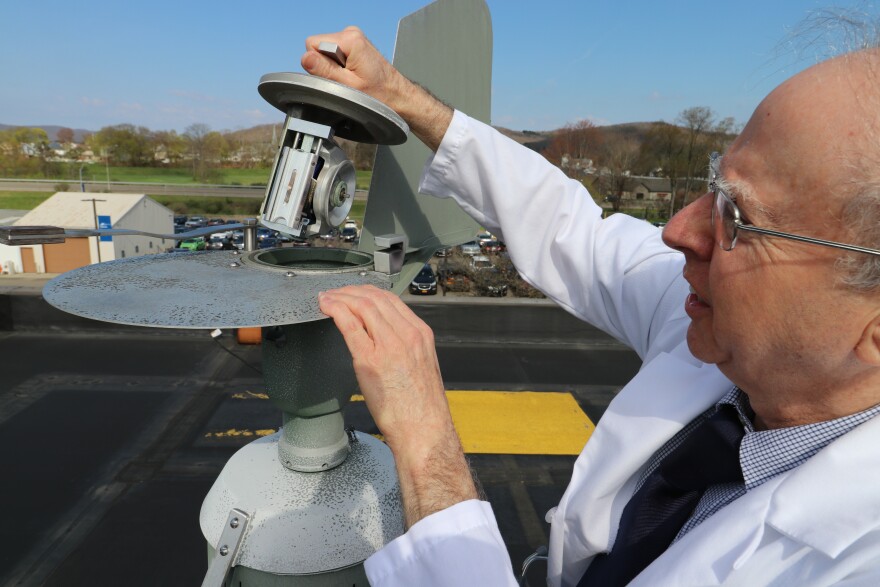It’s that time of year again. The sneezing, the runny nose, the itchy, watery eyes. Allergies are picking up. But how do we know just how bad allergy season is? WBFO reporter Avery Schneider takes us to Olean, to explain the science behind the pollen count.
If you think you’d find someone tracking allergies out where the birds are chirping and the grass is getting mowed, think again.
It’s actually happening on top of a two-story medical building.

“It’s actually kind of cool to climb up on the roof,” said allergy specialist Dr. Fred Lewis.
On a warm and breezy spring day, Lewis checks out some air samplers, including one called the Rotorod.
It looks like a grey plastic box with a small helicopter blade on the bottom. Attached to the blade are two Lucite rods that get spun 144 times each day at high speed. As they’re spinning, they’re catching samples of pollen grains and mold spores.
A few feet away is the Rotorod’s counterpart, a mechanical contraptions called a Burkard Air Sampler.
“It’s like a giant weather vane,” said Lewis, giving his best estimation.

To take it a step further – a weather vane that got mixed with a model of the Starship Enterprise. It’s about two and a half feet long with a dull green paint job and, on the front, an opening like a whistle.
“It sucks air in through this little slit,” Lewis explained. “There’s a slide inside that goes past the slit… And particulates in the air stream will hit the slide and stick to it because the slide is greased with a silicon grease.”
Lewis has been running this equipment for 34 years. He said when he began, methods to track allergens had become outdated.
“So to know how to best serve my patients and to know what they were actually exposed to, I wanted an idea of what was in the air, and try to correlate that to their clinical history and their skin test results,” said Lewis.
Lewis got special training in aerobiology at the University of Michigan. Then he set up his equipment and joined the National Allergy Bureau – a network of 84 counting stations across the country and eight more around the world that keeps tracks of allergens. It’s part of the American Academy of Allergy, Asthma, and Immunology.
Each day of the year between when snow stops falling and when it picks up again, the samples from Lewis’ equipment are carried down the ladder from the roof, and into a lab.
Cindy Peters is one of the medical technologists who takes it from there. She does the actual counting.

Peters looks at the slide under a microscope. To keep count, she clicks a tallying device that looks like a row of typewriter keys. Each click is another grain of pollen or a mold spore.
“Generally what we do is we’ll count all the pollen grains first,” said Peters. “They’re counted on a different magnification.”
Each one has its own unique size and shape – what’s known as “surface morphology.” And Peters has her own creative ways of telling the samples apart.
“So I was hoping I could see something really fun, like this is a pine pollen,” she asked, pointing to a decades old guide book of pollen grain images. “What does that look like to you,” she asks. “We call it ‘Mickey Mouse.’ It has the central face with the two ears.”

Once the counting is done, Peters compiles the data in a binder. A copy goes to the National Allergy Bureau for analysis, and another goes to local media outlets for the public.
“You know, there’s a lot of allergy and sinus sufferers in our area,” said Peters. “Even here in the lab, different techs will shout out, ‘Hey, what’s in the air today? You know, I’m having a difficult time. My eyes are watering, or I’m sneezing a lot.’”
But all this collection and analysis takes time. So that pollen count you see on the morning news is at least a day and a half old.
According to Lewis, there’s no way to make truly accurate predictions for the season ahead.

“People guess all the time, but I’m not sure they’re actually better than a person throwing a dart at a dart board,” said Lewis.
But in the end, does it serve his original purpose of better treating his patients? Lewis said, “Definitely.”
“I’ve changed how I do my therapy based on what I’ve seen in the air. My testing is set up based on what has been out there, and if I put somebody on immunotherapy – or allergy shots, the colloquial term – it’s based on what they're exposed to and what their skin tests tell me, and the comparison of that particular data,” said Lewis.
So next time you feel that sneeze coming on, rest assured – someone’s keeping an eye on why.

Tracking pollen and mold goes back way before Dr. Fred Lewis started his work 34 years ago. The information collected can be used to monitor changes in our environment and the global climate. Learn more in the added content below.

Dr. Fred Lewis demonstrates the spinning action of the Rotorod Model 40 Air Sampler. The rods on this machine get spun 144 times each day.
Follow WBFO's Avery Schneider on Twitter @SAvery131.













